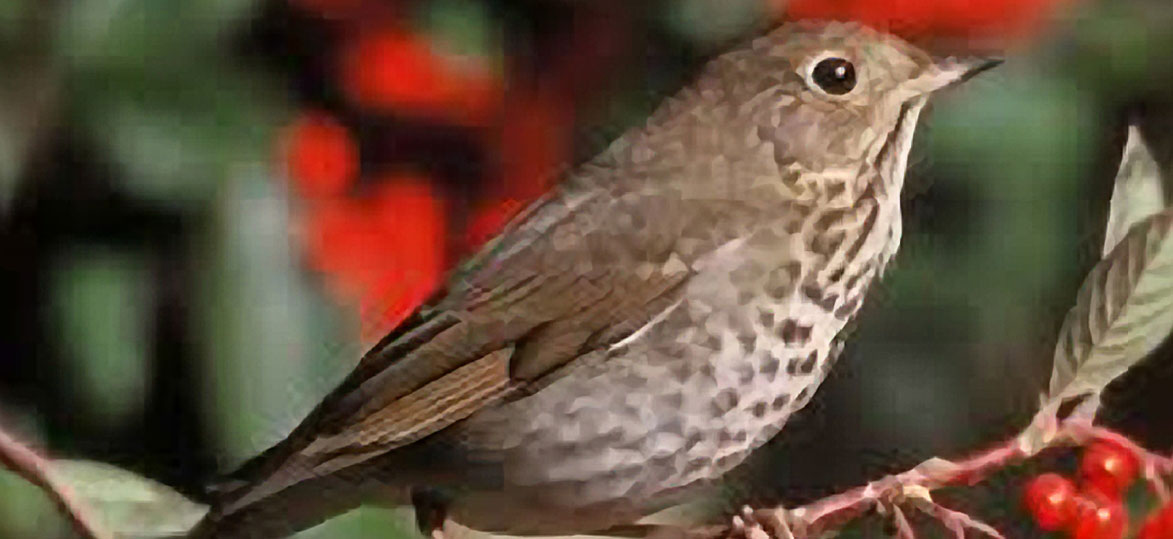
The Hermit Thrush (Catharus guttatus) is the official state bird of Vermont. It is a small brown bird with a spotted breast and a reddish tail. Its musical flute-like song is one of the most beautiful of any North American bird, earning it the nickname American nightingale.
Habitat
The Hermit Thrush is found in a variety of woodland habitats. This species prefers forest interiors with openings, such as ponds or meadows close by. For breeding the Hermit Thrush utilizes young to mature mixed woodlands and moist coniferous forests. The Hermit Thrush leaves Vermont in late fall and it winters south of Pennsylvania. Wintering habitat characteristics include dense cover of woody plants and berry producing vegetation.
The Hermit Thrush can be distinguished from other thrushes in the field by its tail flicking. When a hermit thrush lands on a branch, it often raises and then lowers its tail quickly back and forth. It also produces a certain "tchup" sound when doing this tail wagging. The hermit thrush can also be seen flicking its wings while resting on a perch.
The Hermit Thrush is territorial at both breeding and wintering grounds. During breeding season, the male defends its nest while the female incubates the eggs. In wintering areas it is speculated that the competition for food and cover causes the thrush to become territorial. It is diurnal, mostly active during the day, as it forages and searches for prey on the ground and in vegetation.
Reproduction
The Hermit Thrush leaves Vermont in mid-October and is one of the first woodland birds to return in the spring, arriving in April. It rarely attempts to winter in Vermont, but is sometimes show up at birdfeeders. The nesting season is from mid-May to mid-August and the Hermit Thrush may raise a second brood, but usually only one.
The male arrives before the female to establish its territory. When the female first arrives, the male displays hostile behaviors towards her. However, after a three-to four-day courtship flight that involves the male chasing the female in circular patterns, the female is finally accepted. The female Hermit Thrush then builds a cup nest on the ground or in a small tree within his territory. The well-hidden nest is made of mud and coarse fibers such as twig, bark strips and ferns with a fine, soft lining. The female lays three to five pale blue eggs, which she incubates for 12 days. The male feeds the female while she incubates the egg and also guards the nest by singing on a perch some distance away.
When the young hatch, they are born naked, with eyes closed, and completely dependent on their parents for survival. Both the male and female will feed and care for the young. The chicks' eyes open at three or four days of age and feathers appear at seven days. The chicks fledge, or learn to fly, when they are 12 days old.
Diet
The Hermit Thrush eats a wide variety of food items, varying from season to season. In late fall, it flies south for winter. During migration, it eats primarily fruit, such as raspberries, pokeberries, serviceberries, grapes, and elderberries. Fruit also make up a portion of their fall diet here in the northeast before it leaves for its wintering grounds.
During spring, summer, and early fall in Vermont the Hermit Thrush feeds on insects and small invertebrates. Species in its diet include beetles, ants, caterpillars, grasshoppers, crickets, snails, earthworms, and sometimes salamanders.
The Hermit Thrush is a ground forager and can often be seen hopping about in search of prey. It uses its bill to turn over leaves or other organic matter to expose insects for food. Sometimes it will forage higher off the ground, in vegetation or trees while hovering in the air.
Management
There are several ways to attract Hermit Thrushes to your yard. As much of their diet is composed of fruits and berries, planting a berry bush will provide them an excellent foraging opportunity. Thrushes also enjoy raisins, grapes, and suet, which can be offered on a platform feeder. Earthworms and other invertebrates make up part of the Hermit Thrushes' diet as well. These can be encouraged to live in your yard by setting aside a wet area or a small brush pile.
Status
According to bird surveys, the Hermit Thrush population is stable or even possibly increasing. The reasons for this may be due to the fact that it is somewhat tolerant of disturbances and prefers large mature forests. In Vermont, it is commonly found in suitable habitat from April through October in all 14 counties.
